
By Train to Yamagata
By Local Train, Shinkansen, and Mini-Shinkansen to Yamagata City
I was traveling from Aizu-Wakamatsu to Yamagata.
That would involve a local train at the start,
then the futuristic Shinkansen
with a bentō lunch on board,
and a Mini-Shinkansen for the last leg.
I would get settled into my room in Yamagata City
and prepare to explore southern Yamagata Prefecture.
Yamagata has twice the population of Aizu-Wakamatsu,
almost 250,000 people versus 120,000.
Yamadera and its temples and hiking paths are a
short local train ride away.
Yamagata made for a nice base.
Google Maps dynamically regenerates map content every time you load the page. I would expect this to show a twisting brown rail link to Koriyama Station, then a purple rail link north to Fukushima, turning west and becoming twisting and curving north to Yamagata Station. But if you load this page when it's between midnight and 5 AM in Japan, you may see bus routes instead.
Banetsu West Line to Koriyama
I started with a very short train ride from a small station near my guesthouse to the main Aizu-Wakamatsu Station. It was just a 4-minute ride through town.
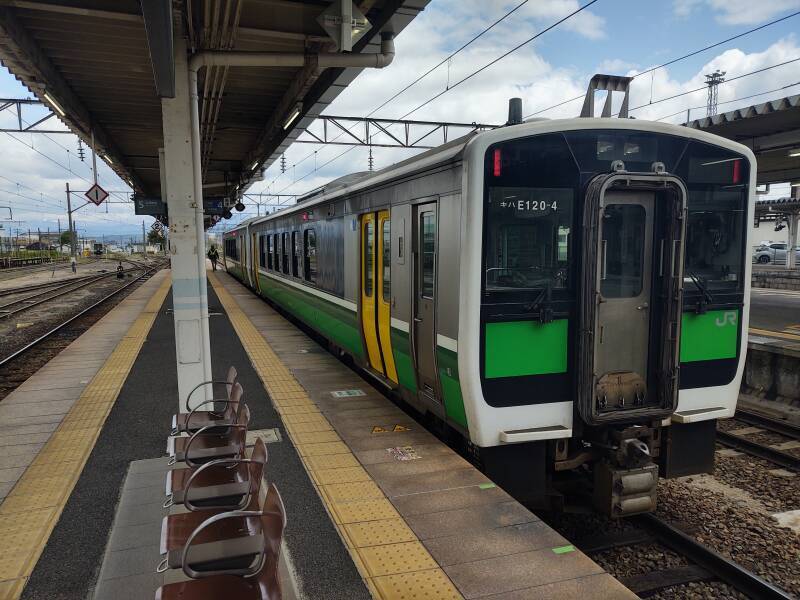
I got a o-nigiri rice ball and bottle of green tea for breakfast at the main station, and waited for the train from there to Koriyama.

I had purchased my ticket the day before. It included travel from any JR station in Aizu-Wakamatsu to any JR station in Yamagata, with a Shinkansen supplement for the Koriyama—Yamagata segment.
I arrived in Koriyama and fed my stack of three ticket slips into a barrier — one for the end-to-end travel, one for the Shinkansen supplement, and a receipt. The barrier returned all three and opened to let me into the Shinkansen area of the station.
There was my train on the schedule board. My train was #137, at 13:18 on track 12, with 17 cars. It's the middle of the three on the right half of the sign. That left me about a half-hour before departure, plenty of time to select a bentō lunch.
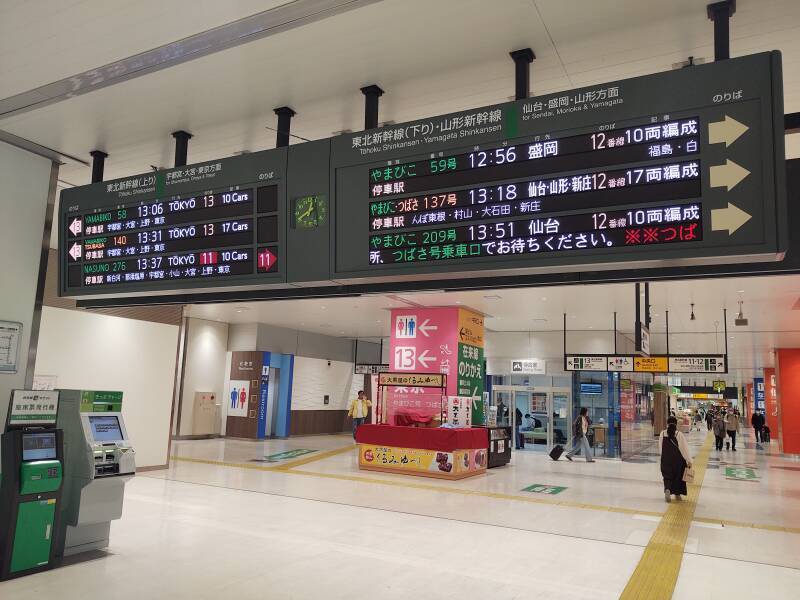
A nearby electronic sign displayed the consist or makeup of the next three or four trains in each direction. I would be in the front section of a two-part train from Tōkyō that would split at Fukushima. The Tsubasa train to Shinjō, versus the Yamabiko to Sendai.

When the train split at Fukushima, I would be in the 7-car Mini-Shinkansen at the front. It would turn west and climb into the mountains, and then turn north to Yamagata and continue north to Shinjō. The 10-car regular Shinkansen at the rear would continue northeast to Sendai.
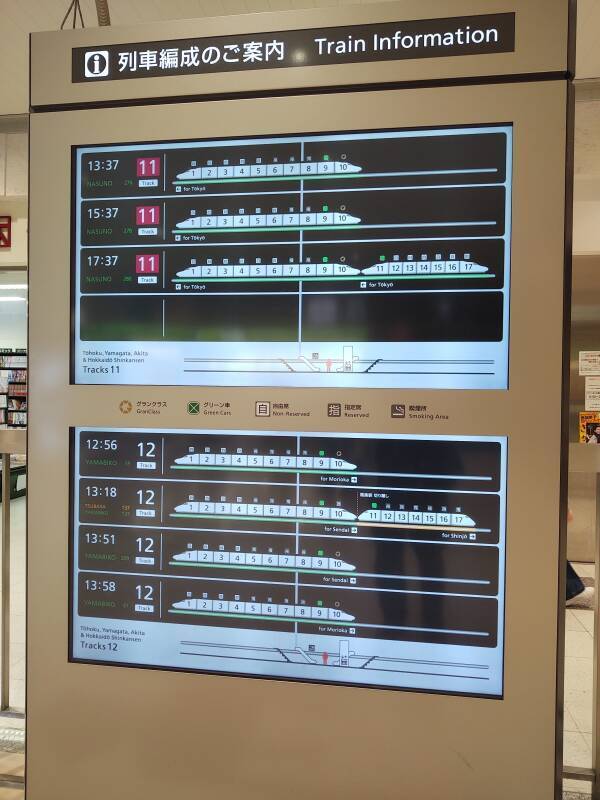
I selected a bentō and went up to the platforms. A south-bound E5 series Shinkansen soon pulled in to the opposite platform. This was 12-year-old technology at the time, introduced in 2011. The E5 can run at speeds up to 320 km/h. It could run at 360 km/h, but the Shinkansen is currently limited to 320 km/h until a noise cancellation system is perfected. The current obstacle to even higher speed is the boom made by a train entering or exiting a tunnel at 360 km/h. Capacity is up to 100 passengers per car, fewer in the odd-numbered cars which contain toilets, wheelchair spaces, cardphone booths, and a conductor's compartment.

An E5 train running as the Tōhoku Shinkansen from Tōkyō to the northern tip of Honshū passed through the station at 320 km/h while I was waiting.
Wow! You have just enough time to spot it approaching, and then it's through and gone in a blur.
A north-bound Shinkansen stopped on the other side of my platform. It was headed for Sendai, Morioka, and beyond. My train, however, would stop on my side of this platform.

My train soon arrived — a 7-car Mini-Shinkansen at the front and a 10-car regular E5 series Shinkansen behind.
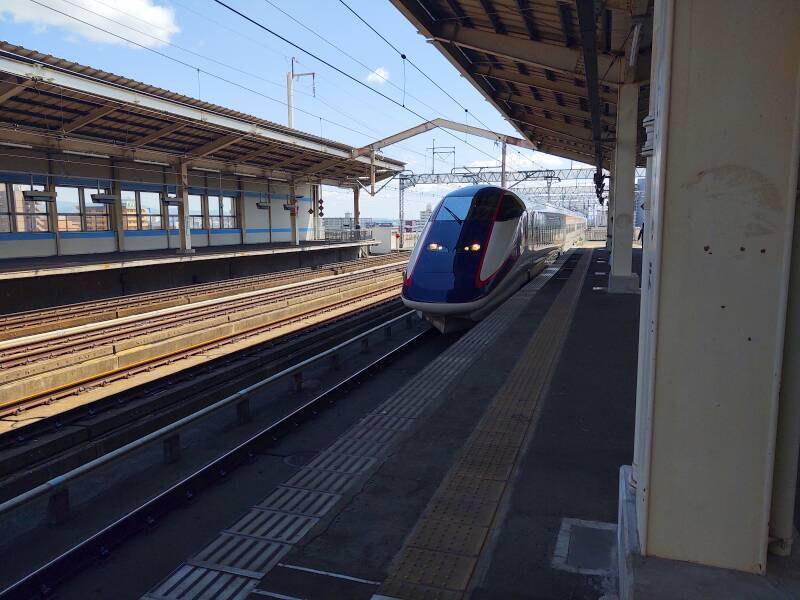
Japan is a volcanic archipelago with rugged terrain. Its railroads mostly use 3 foot 6 inch or 1,067 mm narrow-gauge track to better handle small-radius turns and steep grades. The Shinkansen, however, uses 4 foot 8.5 inch or 1,435 mm standard-gauge track along routes with very gradual curves and grades.
The Mini-Shinkansen is a compromise design. It can run at up to 275 km/h on specially designed Shinkansen lines, as this one did from Tōkyō to Koriyama, and would continue from here to Fukushima.
The train split at Fukushima, with my Mini-Shinkansen section turning west onto what had been a narrow-gauge line recently converted to standard gauge. The Mini-Shinkansen cars are shorter and a little narrower, with 2×2 instead of 2×3 seating. The smaller size allows them to fit through the much tighter curves of the former narrow-gauge lines. Doorway steps fold out to bridge the gap to the platform at regular Shinkansen stations. Each car seats 56–68 people rather than up to 100 on the regular Shinkansen. From Fukushima through Yamagata, where I would get off, and from there on to Shinjō, the train is limited to 130 km/h due to the curves, grades, level crossings, and the fact that it shares the line with regular service trains.
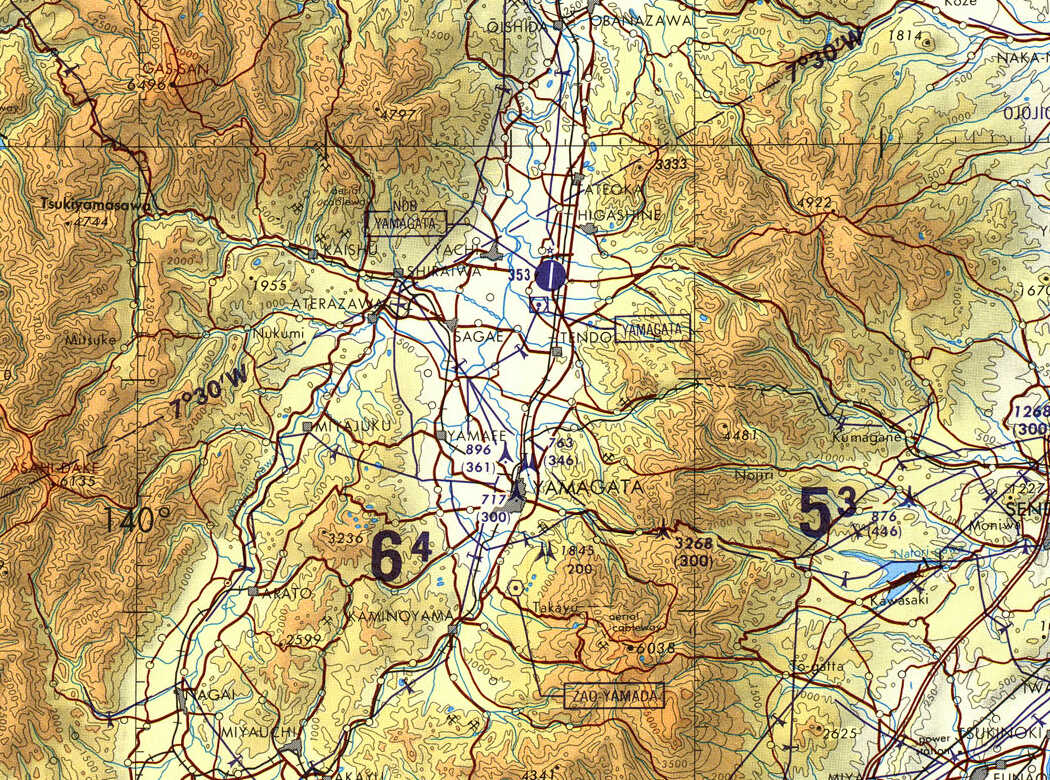
Small portion of 1:500,000 Tactical Pilotage Chart TPC G-11B, from the Perry Castañeda Library Map Collection at the University of Texas. It's a U.S. government map, so elevations and tower heights are in feet. Somewhat similar to Aizu-Wakamatsu, Yamagata City is along the southeast perimeter of a flat basin surrounded by mountains. The Mini-Shinkansen line approached from the southwest, winding more and descending more rapidly than a regular Shinkansen.
On Board
The train had arrived and then departed precisely on time. Of course. We were soon accelerating through northern Koriyama. I had bought an o-nigiri rice ball as a starter.
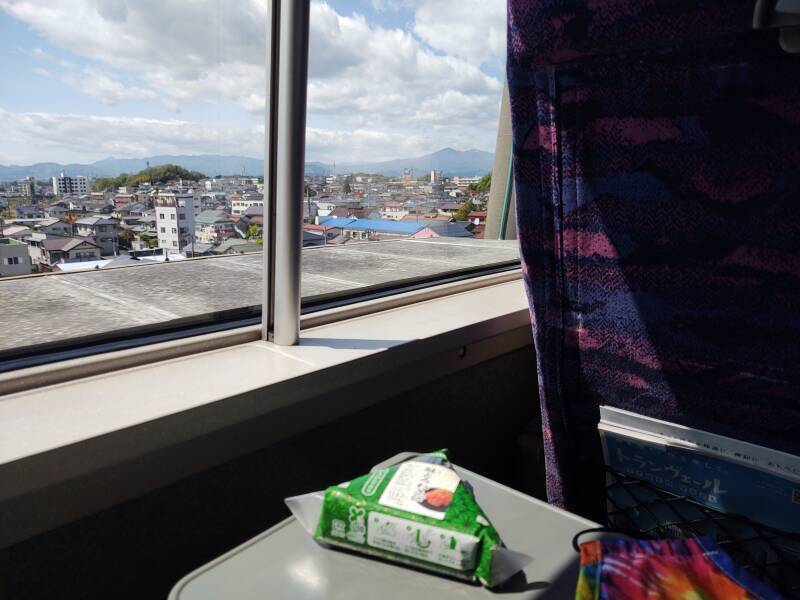
Then I got out my bentō and Suntory ハイボール or haibo-ru, highball.

There was a waxy sheet above the compartments.
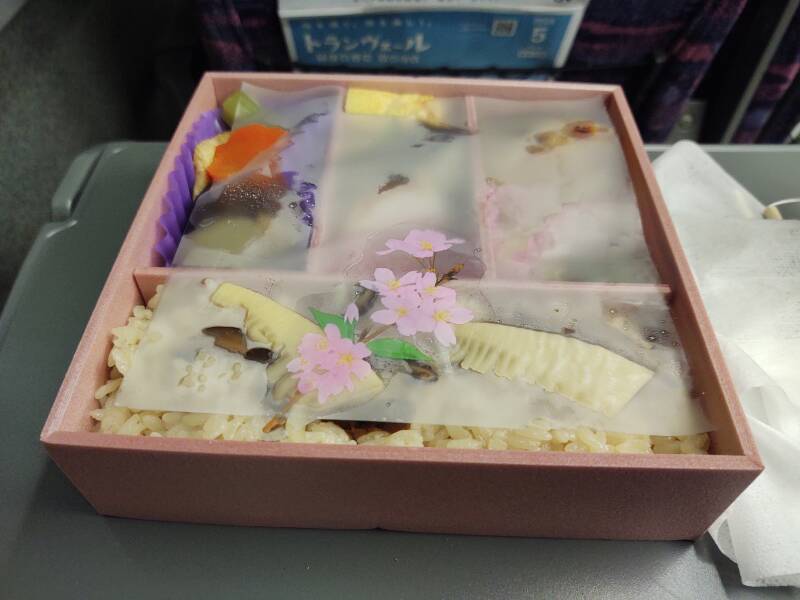
This bentō cost a little under ¥ 1000 or US$ 6.83, plus ¥ 250 or US$ 1.71 for the haibo-ru.
I checked on my way home. At Union Station in Chicago, if the McDonalds is open, you could buy a rapidly cooling greasy meal for US$ 10.69 and up.

Arrival in Yamagata City
I had a room reserved at one of the many locations of the APA Hotel chain. It was just six blocks from the station, straight out and then up the main street. It's one of the towers in the distance on the right side of the street.

This was the most expensive room of the trip. However, at about US$ 80 per night it still was a pretty good deal. That was around the high end of hostel beds in Chicago at peak times, and within the routine range of hostel beds in New York and Boston. And, this is my own room, with a refrigerator, desk, and so on.
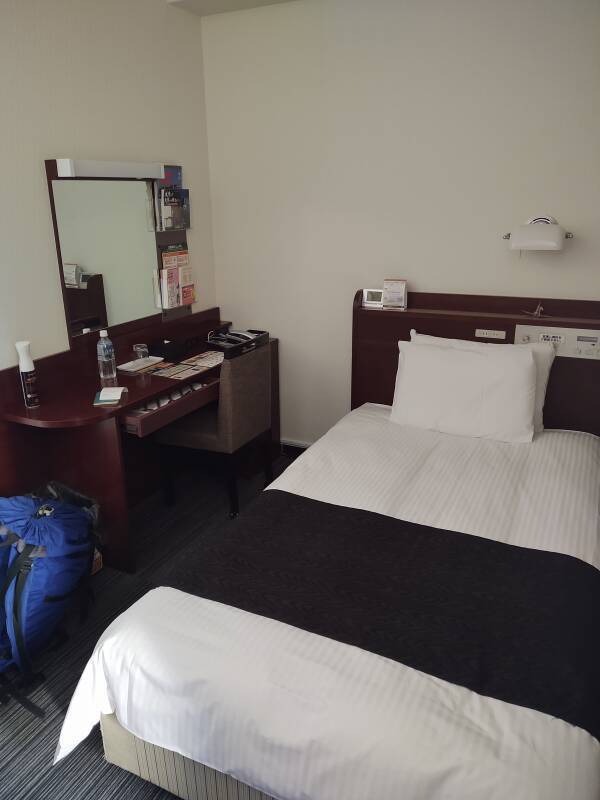

And, of course, my own bathroom with shower, tub, and sink.

Toilet
Controls
Of course the toilet had an arm with the controls for the water spray and drying functions — water temperature, water pressure, and air-drying speed.
The tub was quite deep and short. To use it as a tub, you must fold your legs so your knees are close to your shoulders.
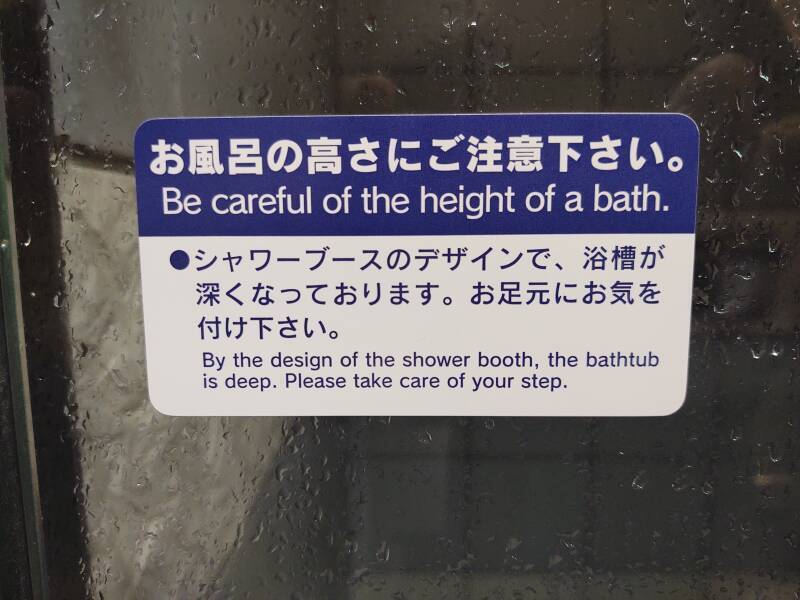
Plus, a room spray with purported deodorant and anti-COVID properties.

I was six floors up with views of the surrounding mountains.
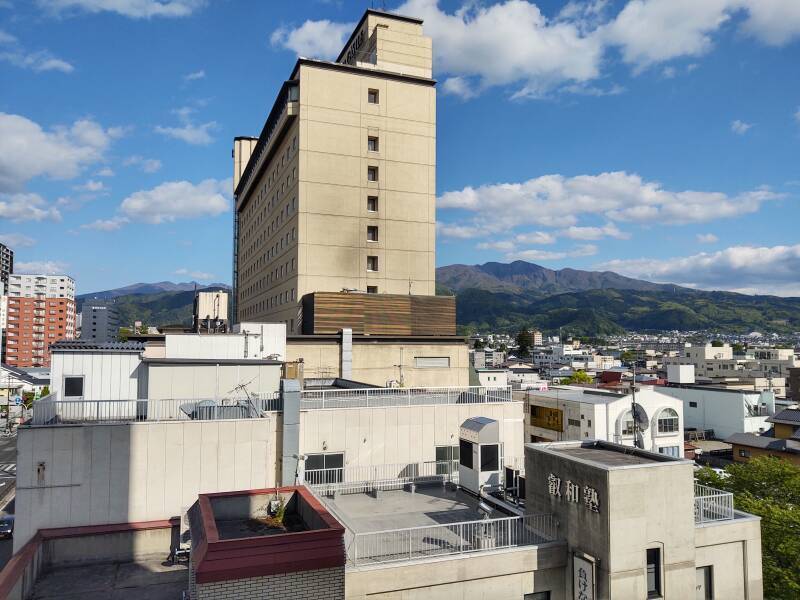
Yama means "mountain", with Yamagata meaning "mountain shape" or "mountain region", and Yamadera meaning "mountain temple". I was staying in Yamagata City, capital of Yamagata Prefecture. I would be visiting the nearby Yamadera complex of temples. Yama, yama, yama.
Japanesetelco towers
In the distance is one of the red-and-white telecommunications towers that you see in most every city in Japan. They once held large horn antennas for point-to-point microwave links. Now their broad platforms hold easily maintained antennas for cellular coverage and their backhaul links, plus local VHF/UHF repeaters.
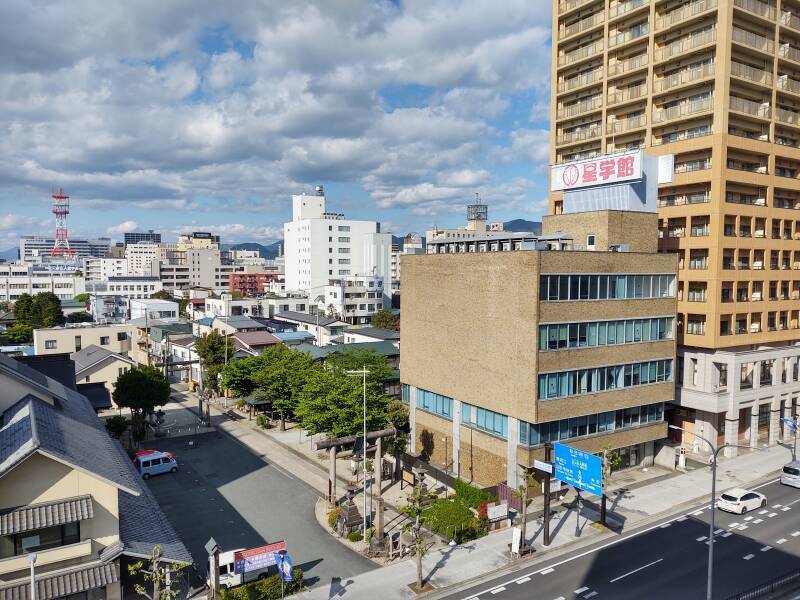
Meals in Yamagata
The streets between the hotel and the train station had many opportunities for dinner.
The first night, I went to a barbeque place where you get your own small gas-powered personal grill on the counter. The menu was overwhelming. I got by with pointing to what other people were having.
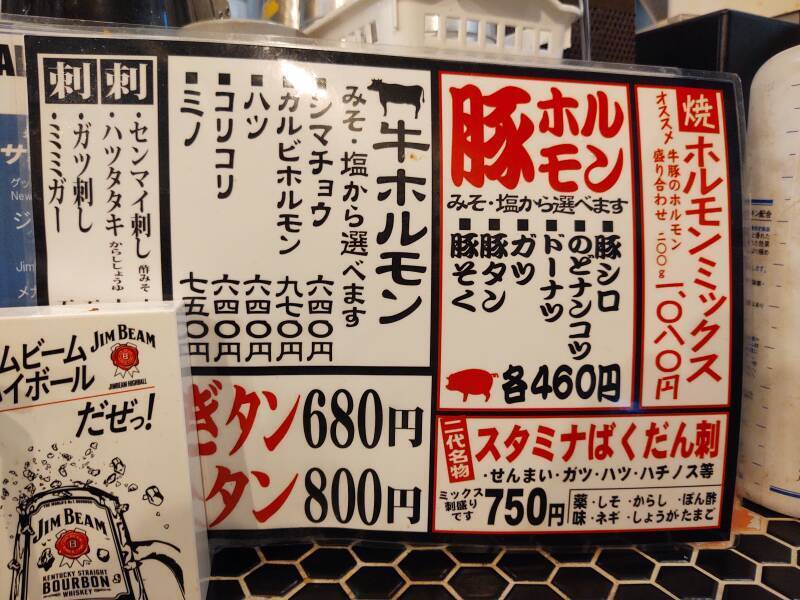
Some cow parts.

And more cow parts. I went along with the staff's suggestion, which involved intestines (on rear plate, and at right on the grill). Digestive tracts form many preferred dishes in Japan, but I find them awfully chewy, like meat-flavored balloons.

I went to a different grill-focused izakaya on another night. There, they cooked it for me. The setsuto or set, combination, included pork intestines on the nearest two skewers.
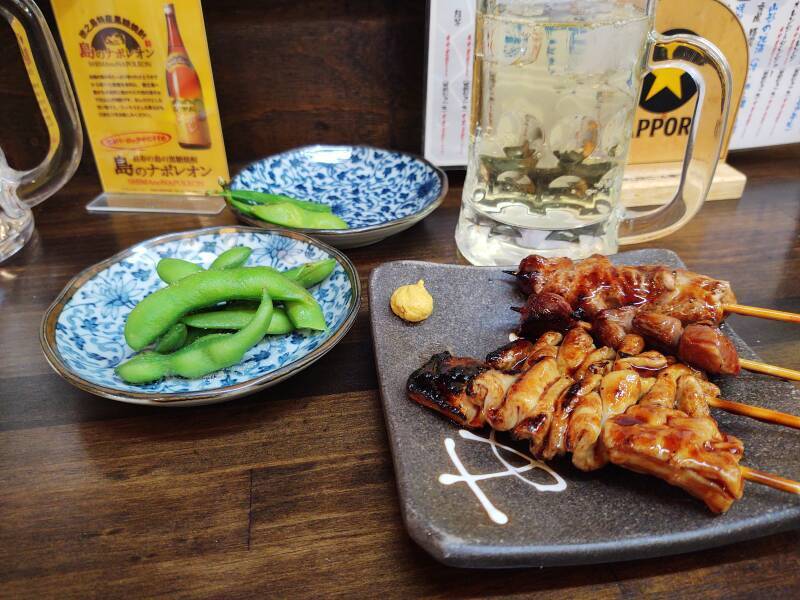
After eventually gnawing that into swallowable bits, I paid closer attention for the next round. That involved standing up to look over the counter and see what was going onto the grill for other patrons. Smile, point, and say "Kore, kudasai." That is, "Please give that to me."
Beef muscle tissue and beef liver were much better!
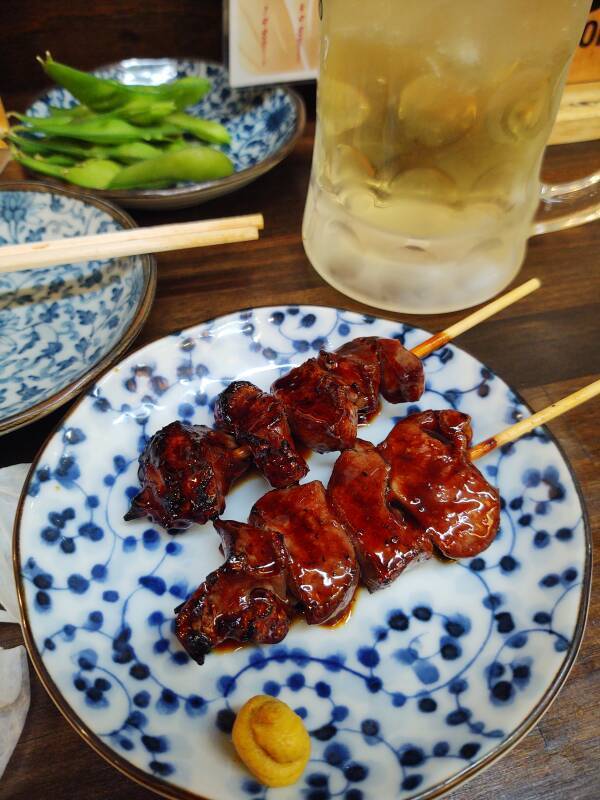
Then another round of that, along with grilled leeks and peppers.
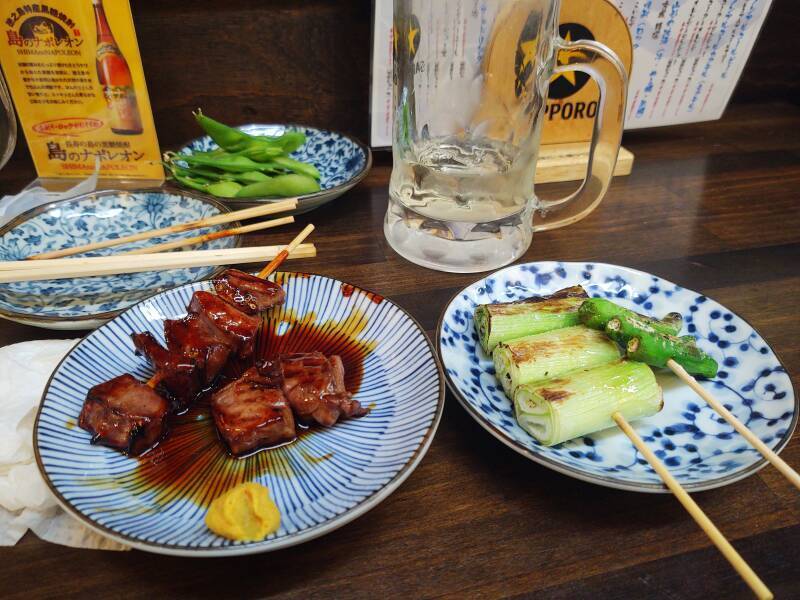
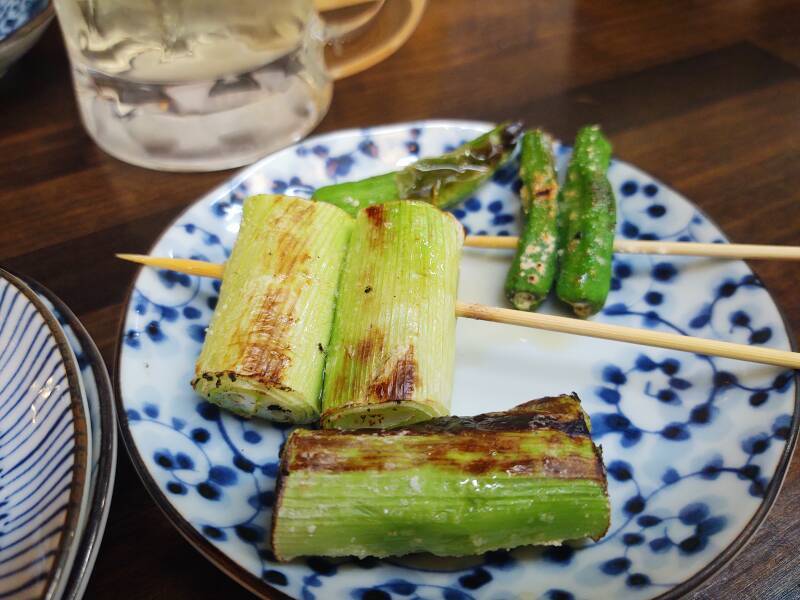
And, of course, several establishments specialized in ラーメン or ramen. I had plenty of choices for dinners during my time in Yamagata.
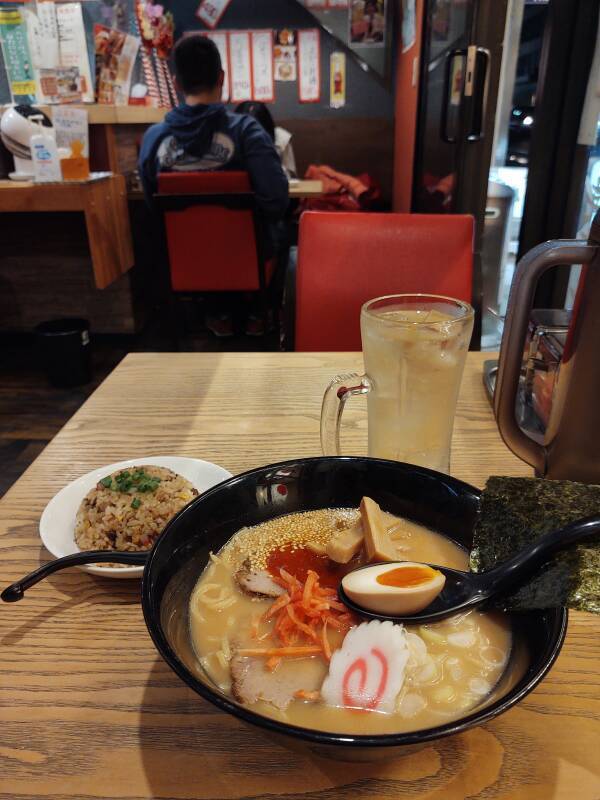
You can stop at the minimart on the way back to the hotel — 7/11 or Family Mart or Lawson Station. They have "One Cup" and similar single-dose pull-top sake, which always looks like Cup-O-Hangover to me.
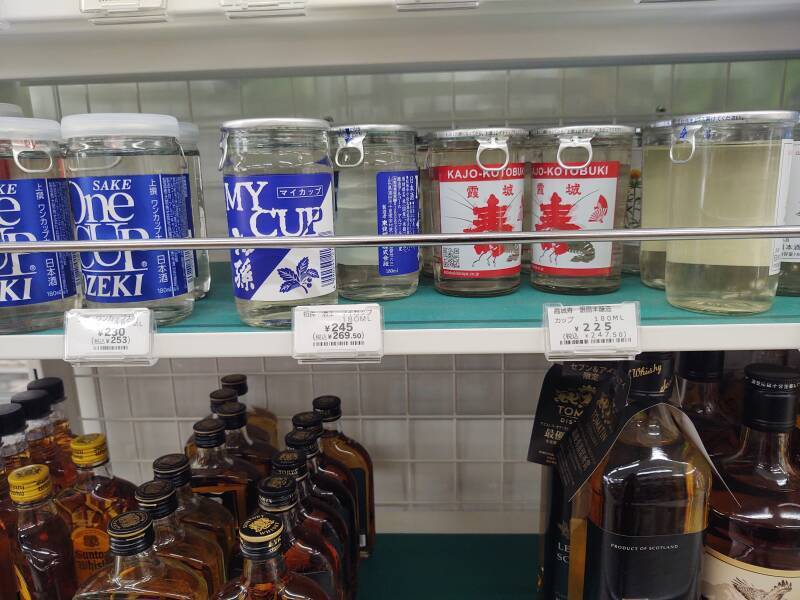
No, the sophisticated evening beverage is a small bottle of the 7/11 house brand sake.


Don the provided yukata or lounging pajamas, sip the 7/11 sake, and check the email.
Notice the bag of 7/11 spicy snacks.
It was in Japan during an earlier trip, either 2017 or 2018, that I had learned the saying "Don't be English." That is, don't drink without eating something. Don't guzzle alcohol and quickly transition through staggering to fall-down drunk like a stereotypical English traveler. Keep your evening classy.
Other topics in Japan:





































7/11 stores are everywhere in Japan and are so Japanese because 7/11 is a subsidiary of the Japanese corporation Seven & I Holdings Co., Ltd. Long ago, like the early to mid 1990s, ATMs accepting foreign cards were rare. Now any 7/11 store has a Seben Ginkō or Seben Bank ATM issuing cash for most any card.